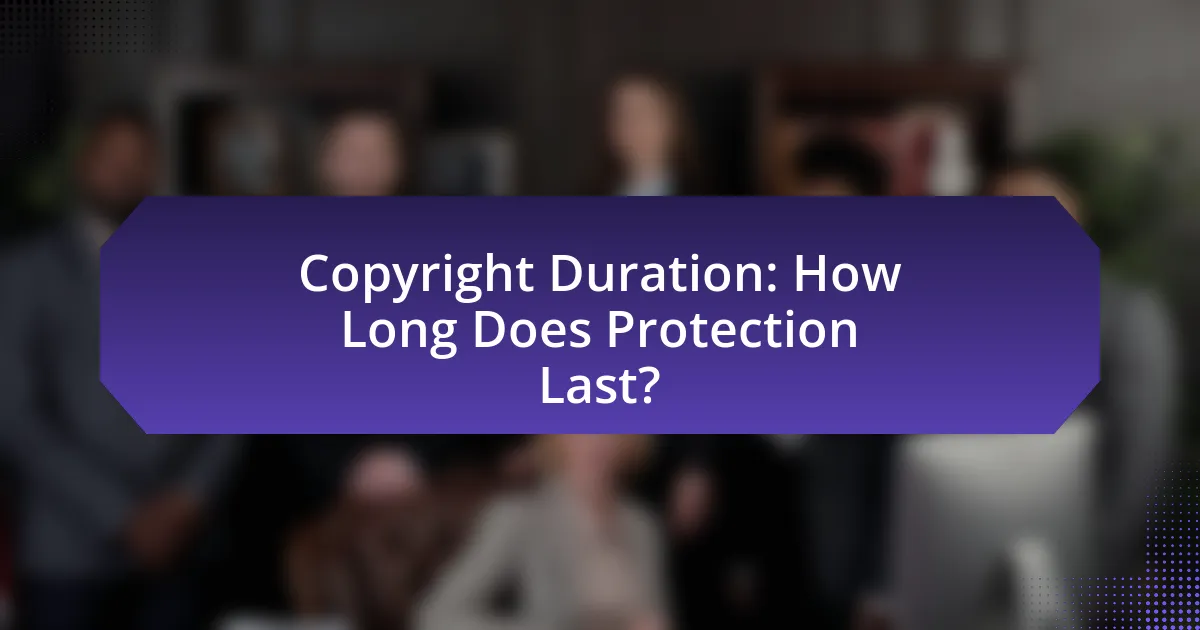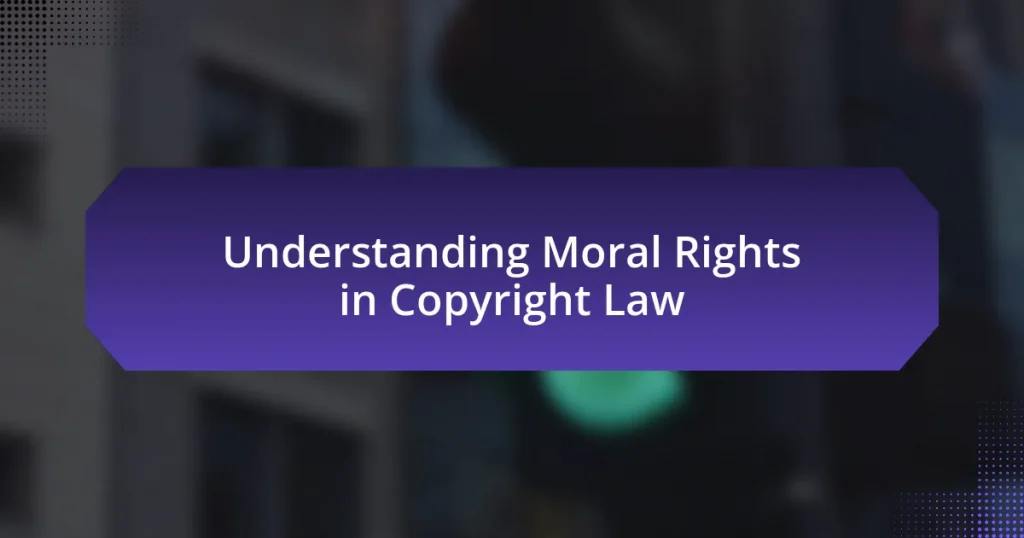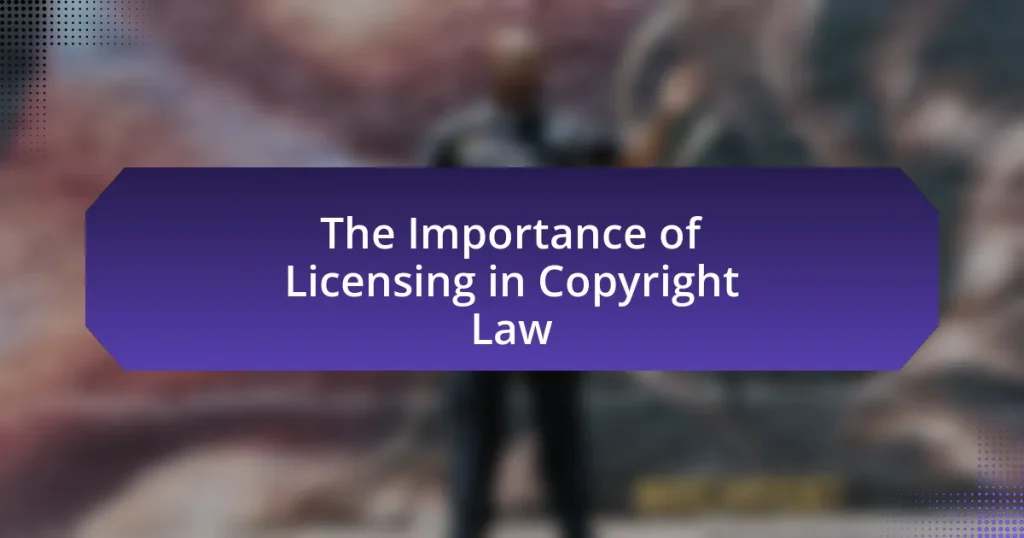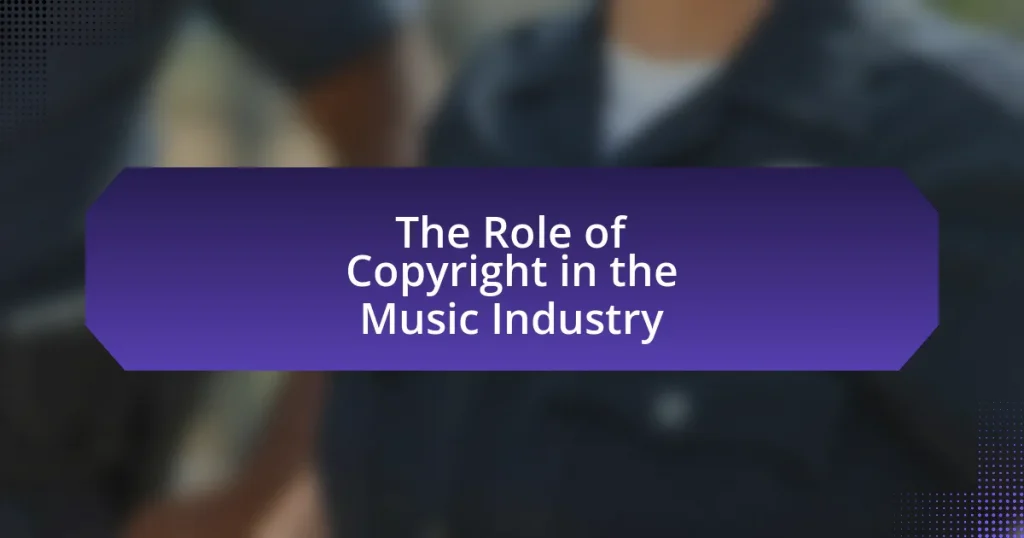Copyright duration refers to the length of time that creators hold exclusive rights to their original works, typically lasting for the life of the author plus 70 years in many jurisdictions, including the United States and the European Union. This article explores how copyright duration is determined, the factors influencing it, and the implications of expiration for both creators and users. It also examines the differences in copyright duration laws across various jurisdictions, the types of works affected, and practical steps creators can take to ensure their works are protected throughout the duration of copyright. Understanding these aspects is crucial for navigating copyright law and maximizing the benefits of creative works.

What is Copyright Duration?
Copyright duration refers to the length of time that a creator has exclusive rights to their original work. Generally, copyright protection lasts for the life of the author plus an additional 70 years in many jurisdictions, such as the United States and European Union. This duration can vary based on factors like the type of work and the date of creation, but the life-plus-70-years rule is a widely accepted standard. For works created by corporations or anonymous authors, copyright typically lasts for 95 years from publication or 120 years from creation, whichever is shorter. These timeframes are established to balance the interests of creators and the public, allowing for a period of exclusive rights before the work enters the public domain.
How is copyright duration determined?
Copyright duration is determined primarily by the laws of the jurisdiction in which the work is created, often based on the life of the author plus a specified number of years. In many countries, including the United States, copyright lasts for the life of the author plus 70 years, as established by the Copyright Term Extension Act of 1998. For works created by corporations, the duration is typically 95 years from publication or 120 years from creation, whichever is shorter. These timeframes are designed to balance the rights of creators with public access to creative works.
What factors influence the length of copyright protection?
The length of copyright protection is influenced by several factors, including the type of work, the jurisdiction, and the date of creation. For instance, in the United States, works created after January 1, 1978, are generally protected for the life of the author plus 70 years, as established by the Copyright Term Extension Act of 1998. Additionally, works created for hire or anonymous works have a different duration, typically lasting 95 years from publication or 120 years from creation, whichever is shorter. Jurisdictional variations also play a significant role; for example, the European Union has harmonized copyright terms, while other countries may have different rules. These factors collectively determine how long a work remains under copyright protection.
How do different jurisdictions define copyright duration?
Different jurisdictions define copyright duration based on specific legal frameworks and historical contexts. In the United States, copyright lasts for the life of the author plus 70 years, as established by the Copyright Term Extension Act of 1998. In contrast, the European Union generally follows a similar rule of life plus 70 years, but also includes provisions for works created by corporate entities, which last for 70 years from publication. Meanwhile, in countries like Canada, the duration was extended to life plus 70 years as of 2015, aligning with international standards. These variations reflect each jurisdiction’s approach to balancing the rights of creators with public access to creative works.
Why is understanding copyright duration important?
Understanding copyright duration is important because it determines the length of time a creator’s work is legally protected from unauthorized use. This duration affects the rights of creators to control their work, the ability to monetize it, and the timing for when the work enters the public domain. For instance, under U.S. copyright law, works created after January 1, 1978, are protected for the life of the author plus 70 years, which ensures that creators and their heirs can benefit financially from their creations for an extended period. Knowing these timeframes helps individuals and businesses navigate legal use, avoid infringement, and make informed decisions about licensing and distribution.
What are the implications of copyright expiration?
Copyright expiration allows works to enter the public domain, enabling unrestricted access and use by the public. This transition fosters creativity and innovation, as individuals and organizations can freely utilize, adapt, and build upon expired works without seeking permission or paying royalties. For instance, works published before 1923 are now in the public domain in the United States, allowing for widespread use in education, art, and media. Additionally, copyright expiration can lead to increased competition and diversity in cultural production, as new creators can draw inspiration from previously protected works.
How does copyright duration affect creators and users?
Copyright duration significantly impacts both creators and users by determining the length of time that creative works are protected from unauthorized use. For creators, longer copyright durations provide extended control over their works, allowing them to monetize their creations and maintain their rights, which can incentivize further innovation. For example, the Copyright Term Extension Act of 1998 in the United States extended copyright protection to the life of the author plus 70 years, thereby enhancing the potential for financial gain for creators and their heirs.
Conversely, for users, longer copyright durations can restrict access to creative works, limiting the ability to use, share, or build upon existing content. This can hinder cultural exchange and the development of new ideas, as seen in the case of works that remain under copyright for decades, preventing them from entering the public domain. The balance between protecting creators’ rights and ensuring public access to creative works is crucial in shaping the landscape of intellectual property.
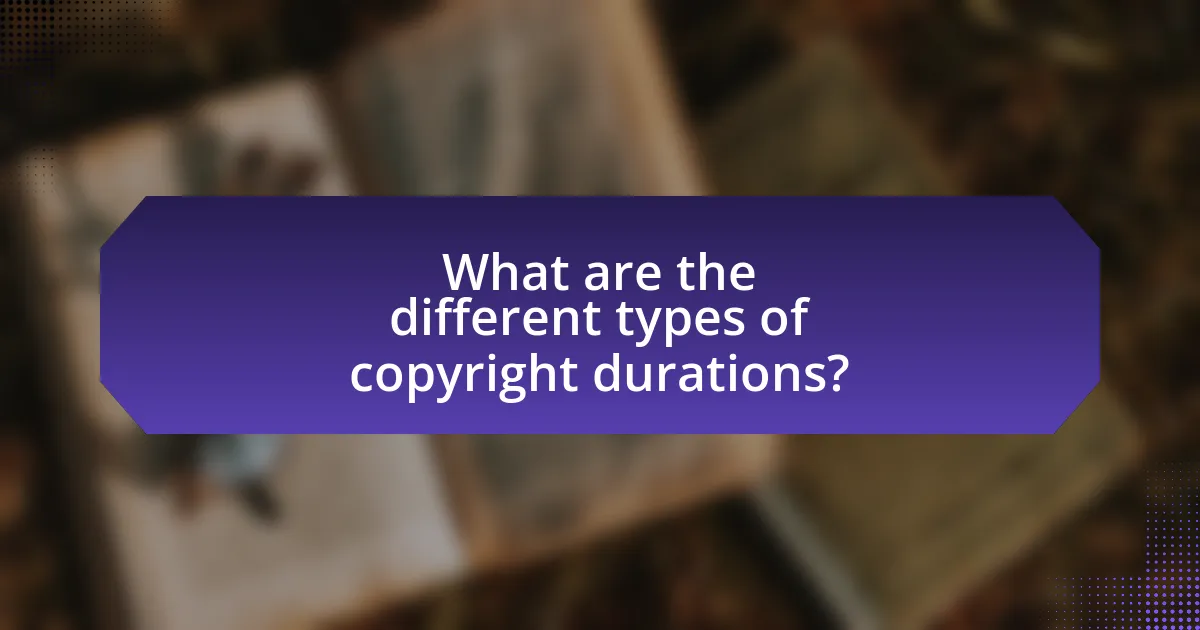
What are the different types of copyright durations?
Copyright durations vary based on the type of work and the jurisdiction. Generally, there are three main types of copyright durations:
-
Life of the Author: Copyright lasts for the lifetime of the author plus an additional 70 years after their death. This duration applies to individual authors and is standard in many jurisdictions, including the United States and European Union.
-
Corporate Authorship: For works created by corporations or organizations, copyright typically lasts for 95 years from publication or 120 years from creation, whichever is shorter. This is applicable to works made for hire.
-
Anonymous and Pseudonymous Works: These works are protected for 70 years after the date of publication, but if the author’s identity becomes known, the life of the author duration applies instead.
These durations are established under various copyright laws, such as the Copyright Act of 1976 in the U.S. and the Berne Convention for the Protection of Literary and Artistic Works internationally.
How long does copyright last for individual works?
Copyright for individual works typically lasts for the life of the author plus 70 years. This duration is established under the U.S. Copyright Act of 1976, which states that the copyright term for works created after January 1, 1978, extends for the lifetime of the creator and continues for an additional 70 years after their death. For works created by multiple authors, the copyright lasts for the life of the last surviving author plus 70 years. This framework ensures that the rights of creators and their heirs are protected for a significant period, allowing for the potential economic benefits of their works to be realized.
What is the duration for works created after a certain date?
The duration for works created after January 1, 1978, is the life of the author plus 70 years. This means that the copyright protection lasts for the lifetime of the creator and extends for an additional 70 years after their death. For works created by corporate authors or anonymous works, the duration is 95 years from publication or 120 years from creation, whichever is shorter. This information is based on the U.S. Copyright Act of 1976, which established these terms to provide a clear framework for copyright duration.
How does the duration differ for anonymous or pseudonymous works?
The duration of copyright protection for anonymous or pseudonymous works is typically 70 years from the date of publication, as opposed to the life of the author plus 70 years for works with known authorship. This difference arises because the identity of the creator is not disclosed, making it challenging to determine the duration based on the author’s lifespan. According to the U.S. Copyright Office, if the author remains anonymous or pseudonymous, the copyright term is fixed at 95 years from publication or 120 years from creation, whichever is shorter. This ensures that the work remains protected for a substantial period, even without knowledge of the author’s identity.
What are the rules for copyright duration extensions?
Copyright duration extensions are governed by specific legal frameworks that vary by jurisdiction. In the United States, for example, the Copyright Term Extension Act of 1998 extended the duration of copyright protection by 20 years, resulting in a total of 70 years after the death of the author for individual works. For works created by corporations, the duration is 95 years from publication or 120 years from creation, whichever is shorter. These extensions are designed to provide additional time for copyright holders to benefit from their works while balancing public access to creative content.
How can copyright holders extend their protection?
Copyright holders can extend their protection by registering their works with the U.S. Copyright Office, which provides legal advantages and establishes a public record of ownership. Additionally, copyright protection can be extended through the renewal process, which allows authors to renew their copyright for an additional term, as seen in the Copyright Act of 1976 that allows for a 70-year extension after the author’s death. This renewal process is crucial for works published before 1978, as it ensures continued protection beyond the initial term.
What are the limitations on extending copyright duration?
Copyright duration can only be extended under specific legal frameworks, primarily through legislative action. The limitations include that extensions cannot be retroactive and must comply with international treaties, such as the Berne Convention, which sets minimum standards for copyright duration. For example, in the United States, the Copyright Term Extension Act of 1998 allowed for an additional 20 years of protection, but this was limited to works created after January 1, 1978, and did not apply to works that had already entered the public domain. Thus, while extensions are possible, they are constrained by existing laws and international agreements that prevent indefinite prolongation of copyright protection.
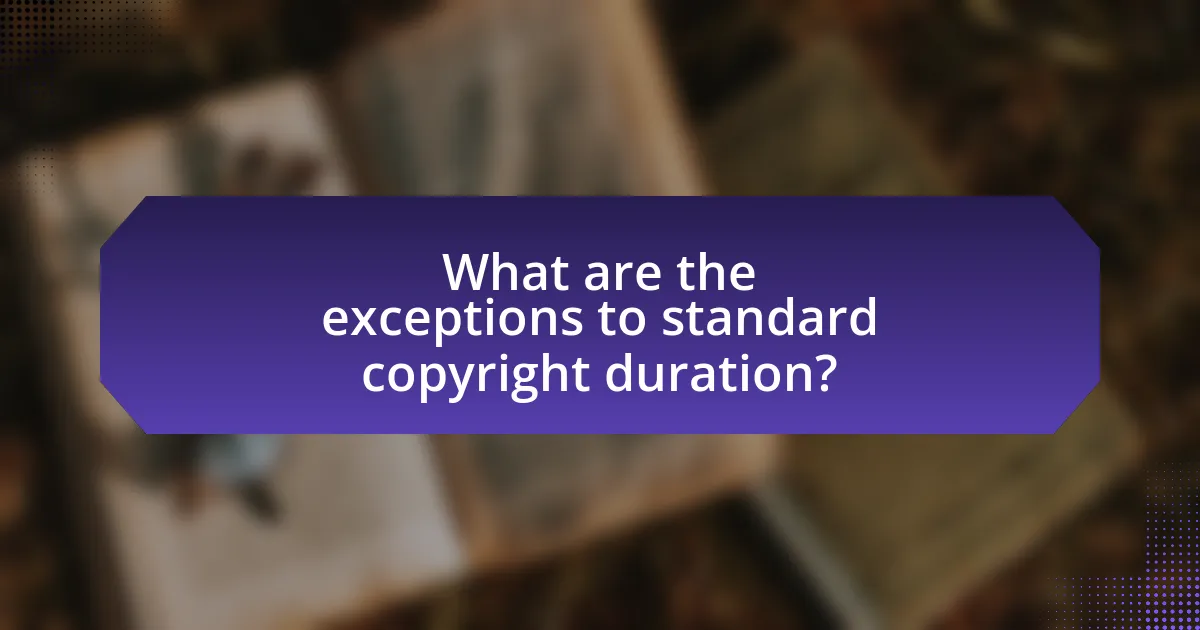
What are the exceptions to standard copyright duration?
Exceptions to standard copyright duration include works created by government employees in the course of their official duties, which are typically considered public domain. Additionally, certain works may have their copyright duration extended due to specific circumstances, such as the death of the author being uncertain or the work being published posthumously. In the United States, for example, works published before 1978 may have different duration rules based on renewal registrations. These exceptions are outlined in copyright law, which varies by jurisdiction but generally aims to balance the rights of creators with public access to creative works.
How do public domain works fit into copyright duration?
Public domain works are those that are no longer protected by copyright, meaning they can be freely used by anyone. Copyright duration typically lasts for the life of the author plus a set number of years, which varies by jurisdiction; for example, in the United States, it is generally 70 years after the author’s death. Once this duration expires, the work enters the public domain, allowing unrestricted access and use. Historical data shows that many classic literary, musical, and artistic works have entered the public domain after their copyright terms expired, illustrating the transition from protected status to public domain.
What criteria determine when a work enters the public domain?
A work enters the public domain when its copyright protection expires. Copyright duration varies by jurisdiction, but generally, works created after January 1, 1978, in the United States are protected for the life of the author plus 70 years. For works created before this date, the duration can depend on whether the work was published and when it was published. For example, works published before 1924 are now in the public domain in the U.S. due to the expiration of their copyright. This framework is established by the Copyright Act of 1976 and subsequent amendments, which outline the specific terms under which works enter the public domain.
How does the concept of fair use relate to copyright duration?
The concept of fair use allows limited use of copyrighted material without permission from the copyright holder, and it is not directly tied to the duration of copyright protection. Fair use applies regardless of how long a work is protected under copyright law, which typically lasts for the life of the author plus 70 years or a set period for corporate authorship. The four factors considered in fair use—purpose, nature, amount, and effect on the market—remain applicable throughout the copyright term, meaning that even after a work’s copyright expires, fair use can still be invoked for works that are still under copyright. This relationship highlights that fair use serves as a legal doctrine that operates independently of the time frame of copyright protection.
What are the international considerations for copyright duration?
International considerations for copyright duration include adherence to treaties such as the Berne Convention, which mandates a minimum duration of protection of the life of the author plus 50 years, and the Agreement on Trade-Related Aspects of Intellectual Property Rights (TRIPS), which extends this to life plus 70 years for many jurisdictions. These agreements influence national laws, leading to variations in copyright duration across countries, but they establish a baseline for international copyright protection. For instance, the United States and the European Union both follow the life plus 70 years standard, reflecting the influence of these international agreements on domestic legislation.
How do international treaties affect copyright duration across countries?
International treaties significantly influence copyright duration across countries by establishing minimum protection standards that member states must adhere to. For instance, the Berne Convention mandates that copyright protection lasts for at least the life of the author plus 50 years, while the Agreement on Trade-Related Aspects of Intellectual Property Rights (TRIPS) extends this duration to the life of the author plus 70 years. These treaties create a framework that harmonizes copyright laws internationally, ensuring that creators receive consistent protection regardless of where their work is used. Consequently, countries that are signatories to these treaties must align their national laws with these stipulated durations, thereby affecting the overall landscape of copyright protection globally.
What are the differences in copyright duration laws globally?
Copyright duration laws vary significantly across different countries. In the United States, copyright lasts for the life of the author plus 70 years, while in the European Union, the duration is also life plus 70 years, but some countries have additional provisions for works created by corporations, extending the duration to 95 years from publication. In contrast, countries like Canada have recently updated their laws to align with the life plus 70 years standard, but prior to this, the duration was life plus 50 years. Additionally, some countries, such as Mexico, have a copyright duration of life plus 100 years. These differences reflect varying national policies and international treaties, such as the Berne Convention, which sets minimum standards but allows countries to establish their own specific durations.
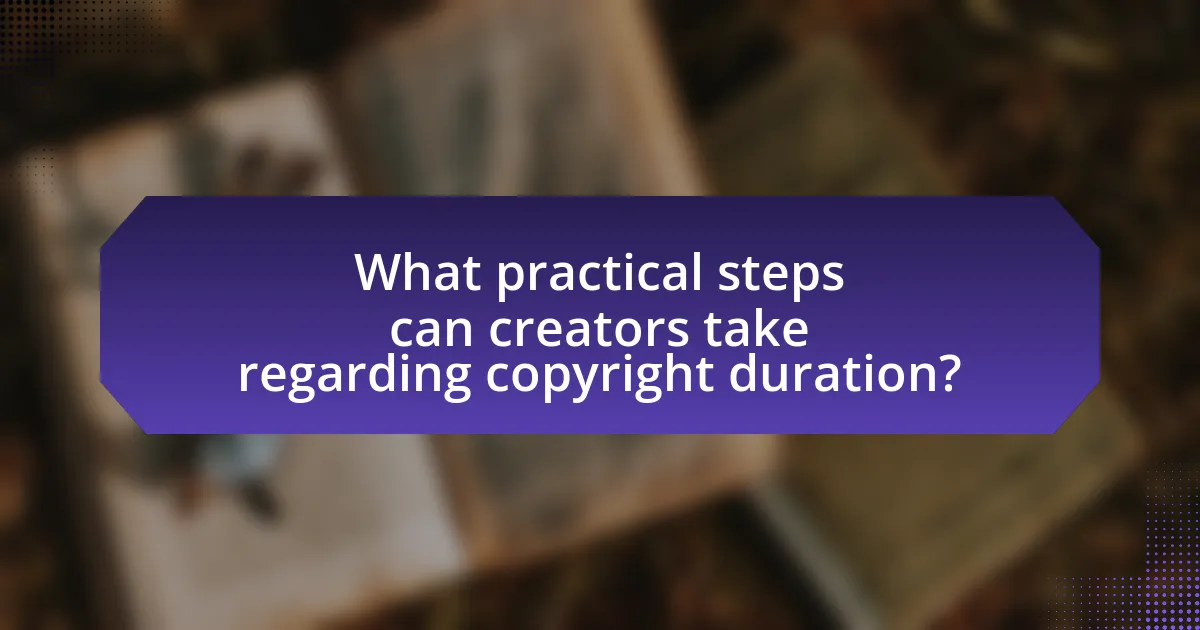
What practical steps can creators take regarding copyright duration?
Creators can extend copyright duration by registering their works with the U.S. Copyright Office, which provides legal benefits and establishes a public record of ownership. Registration is crucial because it allows creators to pursue statutory damages and attorney’s fees in case of infringement, as outlined in the Copyright Act of 1976. Additionally, creators should keep detailed records of their creation dates and any subsequent modifications, as this documentation can help establish the timeline of copyright protection. By understanding the duration of copyright, which typically lasts for the life of the author plus 70 years, creators can strategically plan for the management and potential licensing of their works over time.
How can creators ensure their works are protected for the full duration?
Creators can ensure their works are protected for the full duration by registering their works with the U.S. Copyright Office or the relevant copyright authority in their jurisdiction. Registration provides a public record of the copyright claim and is necessary for enforcing rights in court. Additionally, creators should maintain proper documentation of their works, including drafts and notes, to establish ownership and the timeline of creation. According to the U.S. Copyright Act, copyright protection lasts for the life of the author plus 70 years, ensuring that creators and their heirs can benefit from their works for an extended period.
What best practices should creators follow to maintain copyright?
Creators should register their works with the U.S. Copyright Office to maintain copyright protection effectively. Registration provides legal advantages, such as the ability to sue for infringement and eligibility for statutory damages. Additionally, creators should include copyright notices on their works, which inform the public of their rights and deter unauthorized use. Keeping thorough records of creation dates and drafts can also help establish ownership and the timeline of creation, which is crucial in any copyright dispute. These practices are supported by the Copyright Act of 1976, which emphasizes the importance of registration and notice in enforcing copyright rights.
How can creators monitor the status of their copyright protection?
Creators can monitor the status of their copyright protection by regularly checking the U.S. Copyright Office’s online database, which provides information on registered works. This database allows creators to verify if their work is registered and to track any changes in copyright status. Additionally, creators can set up alerts through copyright monitoring services that notify them of potential infringements or unauthorized use of their work. These services often utilize advanced technology to scan the internet for unauthorized copies, providing creators with timely updates on the status of their copyright protection.
